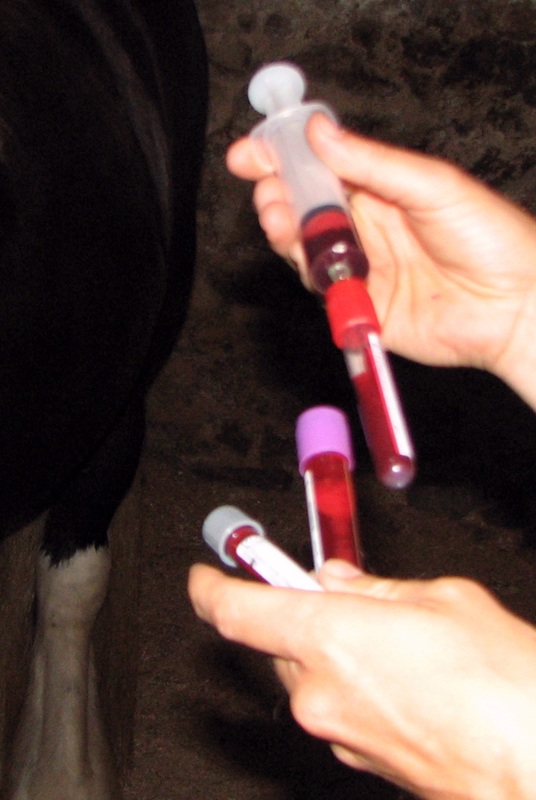| Following on from the post suggesting a possible link between iron and laminitis, owners often contact TLS to ask whether an iron supplement should be fed to a laminitic horse that has been "diagnosed" as being anaemic. According to at least one expert equine vet, anaemia may be one of the most over-diagnosed problems in equine medicine. Older horses, horses that are not fit and colder blooded types tend to have lower red blood cell (RBC) counts than younger fitter TB types (upon whom normal ranges are often based), leading to the misdiagnosis of anaemia. "Anaemia" is not an illness - it is a symptom, and the cause of the loss, destruction or lack of production of the RBCs must always be found and addressed. The calculations on the blood test results - MCV, MCH and MCHC - help give an indication as to the type of anaemia - whether it is regenerative (where bone marrow increases production of RBCs according to demand, e.g. haemorrhage or haemolysis) or non-regenerative (where it doesn’t, e.g. anaemia of chronic disease, bone marrow or renal disease. |
A bit about red blood cells - haemoglogin contains iron – iron binds oxygen. RBCs are broken down all the time by the body, new ones made. Iron is so toxic (for a start, bacteria can use iron to multiply) that the body keeps it under lock and key, so as soon as a red blood cell is broken down, the iron is locked away until it is used to make a new RBC. Many illnesses, e.g. piroplasmosis, involve the breakdown of RBCs - this is haemolysis. Other reasons for haemolysis include feeding garlic, which causes Heinz bodies (damage to the RBCs), causing the spleen to destroy the damaged RBCs prematurely. But in all these cases the iron never leaves the body, it is recycled. The only time iron may need to be given to a horse for anaemia is when blood has actually left the body - through haemorrhage, whether acute (bleeding from a wound) or chronic, e.g. worm damage - although in most cases there would probably be enough iron in the normal diet so supplementation wouldn't be necessary. Anaemia of Chronic Disease is another important cause of anaemia in horses, in this it is thought that the inflammation causes iron to be kept locked up - see: Anaemia of Chronic Disease (Wikipedia) - but the answer is to treat the chronic disease, not to increase iron - the body is already worried about having too much iron!
When you read about anaemia in humans, iron supplementation is often mentioned - humans have a very different diet to horses, human diets are often low in iron. But soil is full of iron. Hay and grass contain lots of iron. Feeds like alfalfa and sugar beet contain high levels of iron. There is plenty of iron in a horse's diet, as long as it is fed forage and/or has access to soil. So unless haemorrhage had been diagnosed, iron supplementation should generally not be recommended.
The NRC Nutrient Requirements of Horses 2007 suggests that possible adverse effects of excessive iron might outweigh any supposed advantages, and warns that supplemental iron can be toxic to foals and that iron injections often result in severe reactions and death in horses. Iron is toxic to the liver (hepatotoxic), and vets have reported that excessive iron deposition in the liver is a common finding in liver biopsies from older horses.
When anaemia is suspected, blood should be looked at under the microscope and a CBC (red and white blood cell count) done and correctly interpreted to verify whether the horse really is anaemic, and if so, to indicate the type of anaemia. The cause of the anaemia must be identified and correctly treated - it's treating the primary disease, not feeding an iron supplement, that eliminates anaemia in most cases.
When you read about anaemia in humans, iron supplementation is often mentioned - humans have a very different diet to horses, human diets are often low in iron. But soil is full of iron. Hay and grass contain lots of iron. Feeds like alfalfa and sugar beet contain high levels of iron. There is plenty of iron in a horse's diet, as long as it is fed forage and/or has access to soil. So unless haemorrhage had been diagnosed, iron supplementation should generally not be recommended.
The NRC Nutrient Requirements of Horses 2007 suggests that possible adverse effects of excessive iron might outweigh any supposed advantages, and warns that supplemental iron can be toxic to foals and that iron injections often result in severe reactions and death in horses. Iron is toxic to the liver (hepatotoxic), and vets have reported that excessive iron deposition in the liver is a common finding in liver biopsies from older horses.
When anaemia is suspected, blood should be looked at under the microscope and a CBC (red and white blood cell count) done and correctly interpreted to verify whether the horse really is anaemic, and if so, to indicate the type of anaemia. The cause of the anaemia must be identified and correctly treated - it's treating the primary disease, not feeding an iron supplement, that eliminates anaemia in most cases.


 RSS Feed
RSS Feed